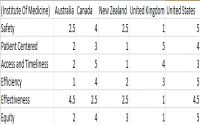Industrial engineers possess the knowledge, training, and experience needed to distribute solutions to improve inefficient systems, like American healthcare. Breakdown in efficiency, caused by factors such as ambiguous communication and ineffective timelines, contributes to patient frustration and dissatisfaction. Industrial engineers are rightly sought out to identify flaws in the healthcare system and to develop effective solutions to these failings, ultimately enhancing patient satisfaction and the standard of care for all American citizens.
Introduction
Healthcare is the largest and among the most important systems in the United States of America. It seems counter intuitive, then, that so many flaws exist in the current system. When comparing the healthcare system in the United States to those of other countries in terms of safety, efficiency, and patient centeredness as well as other factors, the United States ranks among the worst according to the Institute of Medicine (IOM) as seen in Fig. 1[1].
This data illustrates that the current system is flawed, evidenced by the level of patient frustration and dissatisfaction. Several factors contribute to this patient dissatisfaction, including the absence of effective communication, lack of trust in the provider, ambiguity concerning timelines and continuity of care, and the elongated time between the steps in the process.
These alarming figures and ultimate patient dissatisfaction undoubtedly illustrate that reform is imperative. The initial step in this reformation process is to identify the factors that contribute to these disturbing trends, and the challenge lies in the identification and appointment of individuals best suited for this task. Industrial and Systems Engineering, a relatively new field of study, provides professionals with the theoretical knowledge, training, and experience necessary for successfully identifying systemic weaknesses and articulating subsequent solutions that would ultimately improve the standard of care for all American citizens.
Industrial Engineers – Their fit into Healthcare
Industrial engineers apply not only the doctrines of engineering but also the principles of various fields of study such as statistics, economics, and management to improve efficiency and optimize systems. With their training and experience in improving factors such as productivity, safety, and effectiveness, industrial engineers are in a position to play an essential role in improving the efficiency of the healthcare system in the United States. Reflection upon the history of industrial engineering and analysis of how its contributions affected another important American industry – the hospital system – help illustrate how this skill set has previously benefited system efficiency in a number of ways: improving communication between patients, nurses, and doctors; providing patients with more information; and a shortening the transfer time between appointments.
Industrial engineering was developed and defined in the automobile industry with the Ford Motor Company leading the way. This engineering specialty subsequently spread to other car companies and eventually to a variety of industries. In each of these industries, specific methodologies were applied with the goal of increasing efficacy and productivity for each specific company or industry sector.
One of those approaches, the Six Sigma methodology, involves improving the quality of production by identifying defects in the manufacturing process and removing them. This, in turn, minimizes variability in both the business and the manufacturing processes, thereby minimizing costs and maximizing profit. “Six Sigma” is a statistical term and results in a rating that reflects the percentage of products created without defects. In this process, 99.99966% of the products manufactured are expected to be free of defects, meaning that given one million opportunities for something to meet required specifications in a process, 3.4 or fewer of them will be flawed [2]. The Six Sigma method is an example of a tool that industrial engineers can use to analyze a dysfunctional system such as health care. Their specialization in optimization makes them prime candidates for fixing a system whose problems can be broken into a few major factors.
Poor communication between Healthcare Professionals
Nothing triggers frustration and exacerbates dysfunction more than a breakdown in communication. This is especially true regarding an issue as critical and as sensitive as healthcare. Relinquishing control over one’s health or the health of a loved one necessitates trust in the care providers; trust that they are equipped with the tools for concise communication and the ability to meet medical needs of the patient efficiently and effectively. In the absence of effective communication, this trust is in peril.
Industrial engineers are trained to consider human factors when determining solutions to problems. In addressing poor communication, engineers start by surveying those most affected — the end-user who is, in this case, the patient. The initial step in this survey process is identifying precisely at which step in the system’s progress the communication happens. In the case of a hospital visit, communication, both verbal and written, is an integral component throughout the entire stay. The first stage of a hospital visit requires a patient, upon arriving at the hospital, to complete paperwork, which is usually accompanied by both verbal and written feedback to an intake person regarding the patient’s present health concern. Following this first interaction, the patients receive both written and verbal instructions telling them where to go and what to do. Once past this intake point, patients must explain the reason for their visit to multiple individuals – at a minimum, to at least one nurse and one physician. By the time the patient finally meets with a physician, they have already communicated via a variety of mediums with a number of people.
Next, the industrial engineer determines the best methods to apply in analyzing and interpreting the effectiveness of communication. The most efficient way to determine this is by surveying patients in order to assess their perception of their experiences and the quality of care they received during their hospital visits.
A study conducted by industrial engineers in Jackson, Mississippi, which surveyed 44 patients in order to determine patient satisfaction following a hospital visit, provides an example of this method. The survey results show that the number of nurses with whom patients were required to communicate was inversely correlated to the patients’ satisfaction and perceived quality of care [3]. After analyzing the survey results, the hospital changed its policies, and researchers found that minimizing the number of staff members the patient must communicate with led to less frustration and greater satisfaction, indicating that the new policies had a positive impact on communication and overall quality of care.
Industrial engineers possess the knowledge and skills necessary to design reliable survey instruments as well as the ability to analyze the resulting data in a technically sound and efficient manner.
Poor communication with Patients
Another problem identified in the US healthcare system is that patients are often unaware as to the timeline of their treatment, which is especially significant for patients who require particularly serious medical attention. In general, the ambiguity concerning the timeline and continuity of care leads to greater general patient dissatisfaction. It is most certainly unnerving for patients whose health is in jeopardy to perceive that they are being put on hold, left confused and uninformed about how the steps in their care plan will unfold. Often multiple specialists, who may provide conflicting feedback, are assigned to a single patient, contributing to the lack of clarity pertaining to the continuity of care or the step-by-step plan for treatment.
Industrial engineer Sherry Weaver first noticed this problem while at the hospital with her father, an experience that inspired her to use her background in engineering to improve the efficacy of communication within this healthcare setting. Weaver defines this problem as the lack of a “quarterback” on the team of specialists working with a patient. She contends that the shortfall in the system is that no one single individual is assigned to coordinate scheduling and be in direct and consistent contact with the patient; in other words, there is no “quarterback” [4].
In order to address this problem, Weaver created a computer-mapping program to help predict appointment timing in hospitals. The program takes into account various factors – including the urgency of each patient’s appointment, operating room availability, each patient’s length of stay, and care pathway – about each patient in order to determine an approximate time frame that would be optimal for scheduling a patient’s procedure [5]. Analysis of these dynamics with statistical principals such as Six Sigma leads to determining a possible schedule for the patient, which results in improved quality of care and increased patient satisfaction as the likelihood of patient compliance and preparation for appointments and treatments increases. Weaver further notes that there is a need for someone to take charge in terms of arranging and communicating these logistics to the patient, the aforementioned “quarterback.” Weaver calls her “quarterback” a “case manager,” a registered nurse who is assigned to a specific patient to keep that patient informed about the scheduling of appointments and timeline of care and to provide accurate and thorough explanations and feedback so as to improve patient satisfaction in hospitals. Weaver is just one example of an industrial engineer encountering an ineffective system and applying her background to identify the contributing problems and treating them.
Delay
Another contributing factor to patient frustration and perceived poor quality of care is the elongated time between the steps in the process of receiving treatment at a hospital. Many patients go to the ER and must wait for an extended period in a waiting area before being admitted and often return to the waiting area for another long wait before they can see a doctor. This is followed by further waiting periods if a doctor initiates the processes of testing, intervention, or treatment.
As with the previously highlighted problems, the most important thing for the industrial engineer to do in seeking a solution is to first take into account all the factors of a problem. Engineers start by determining all of the possible locations that each patient is expected and required to visit and then estimating possible time frames for each of these stops. Through analysis of the system, it is clear that the steps of a patient’s visit are interconnected—if one stop is delayed, so are the rest.
A partnership between the Industrial and Systems Engineering department and the Keck School of Medicine at the University of Southern California focuses on reducing the time it takes for patients to transition through each step in a hospital stay. Their research demonstrates that flow charts are the most effective way to organize information that would minimize the time between each step in a hospital visit. Thus, engineers take into account each patient’s level of medical need, the obtainable resources in the hospital, and time and space available and required for treating each patient.
To understand how industrial engineers outline and apply Six Sigma processes using flow charts, refer to figure 2 above, which displays a sample flow chart similar to those used in ongoing research at USC.
“The engineering approach makes this study unique,” said David Altman, Assistant Dean of the Keck School of Medicine. “We’re looking at process issues that we don’t normally look at. There’s a lot that the industrial world has been figuring out that we don’t know much about in healthcare, but it could be applied to us and be tremendously beneficial” [4].
Conclusion
The daunting task of healthcare reform in the United States will require an approach that is not only innovative and creative, but also one that capitalizes upon the application of proven analytical processes to improve systems. Improving the overall efficiency of the healthcare system has proven to be one of the best arenas for industrial engineers to apply their knowledge because they are the only professional trained in all facets of the problem—the industrial engineer. The unique profession of industrial engineering incorporates human factors with design, and capitalizes upon the effective use of the latest technology. This unique set of skills is crucial to the analysis of countless systems in today’s technology-based world. The health care system in particular has much to gain through the through the application of the principles of industrial engineering.




